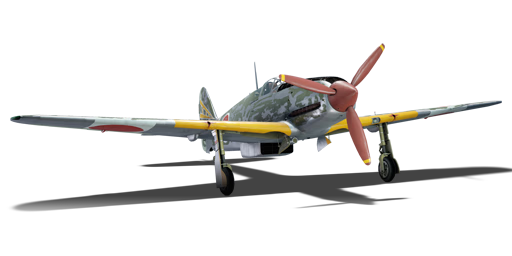



The Ki-61-I ko is a Japanese fighter. It has been in the game since the start of the Open Beta Test prior to Update 1.27.
While Japan is famous for turn-fighters like the Zero, the Ki-61 Hien will make "boom and zoom" pilots feel at home. Possessing good high altitude performance, good climb rate and good diving capabilities, this "energy fighter" flies much like the Bf 109 which inspired its design... though the Japanese traded quite a bit of firepower in favour of manoeuvrability. This allows the Hien pilot to choose what role he or she wants to play in the battle. One could play the reserved, high flying energy fighter, or if the situation dictates, the aggressive low flying dogfighter (against certain opponents). Compared to the "Zero" it is faster, has a higher climb rate, and handles better at higher speeds... but is no match in overall manoeuvrability.
The Ki-61-I ko has a rather weak armament and lacks flexibility, as it is unable to equip bombs or ground targets belts. The Ki-61-I ko utilises two 12.7 mm Ho-103 machine guns and two 7.7 mm Type 89 machine guns. Generally, both are unreliable and it often takes hundreds of rounds to destroy an enemy plane. This is due to the lack of primer in the rounds themselves. 12.7 mm rounds fired by the M2 Browning may seem to do more damage because they have more primer which dictates how fast the round will exit the barrel. Due to this, it is necessary to get up close to enemies. Aim for the engine, pilot, or fuel tanks if the location is known. Remember to lead with these machine guns, as the rounds are not high velocity. The 7.7 mm rounds will hardly damage any plane with armour, so the Hien relies on its 12.7 mm guns which are fairly lacklustre.
The low muzzle velocity of both weapons means that pilots may have to close to short range in order to hit and deal significant damage to targets. Even so, it will require some time to critically damage tougher aircraft such as bombers or attackers. However, with accuracy and shot placement, the large ammunition pool can work to your advantage.
The Hien also comes equipped with an armoured plate at the pilot seat as well as rudimentary self-sealing fuel tanks.
flaps
flaps
flaps
brake
| Belt | Belt filling | Armor penetration (mm) at a distance: | |||||
|---|---|---|---|---|---|---|---|
| 10 m | 100 m | 500 m | 1000 m | 1500 m | 2000 m | ||
| AP-T/AP/HEF-I | 21 | 19 | 13 | 7 | 4 | 3 | |
| AP-T/HEF-I/AP/HEF-I | 21 | 19 | 13 | 7 | 4 | 3 | |
| AP-T/HEF-I/HEF-I/HEF-I | 21 | 19 | 13 | 7 | 4 | 3 | |
| AP-T/AP/AP-T | 21 | 19 | 13 | 7 | 4 | 3 | |
| AP/HEF-I/HEF-I/HEF-I | 21 | 19 | 13 | 7 | 4 | 3 | |
| Belt | Belt filling | Armor penetration (mm) at a distance: | |||||
|---|---|---|---|---|---|---|---|
| 10 m | 100 m | 500 m | 1000 m | 1500 m | 2000 m | ||
| T/AP/IAI/AP/I | 13 | 12 | 7 | 3 | 2 | 0 | |
| T/AP/IAI/AP | 13 | 12 | 7 | 3 | 2 | 0 | |
| T/T/T/AP | 13 | 12 | 7 | 3 | 2 | 0 | |
| I/AP/AP/AP/IAI | 13 | 12 | 7 | 3 | 2 | 0 | |












Flight performance | |
|---|---|
Survivability |
|---|
Weaponry |
|---|